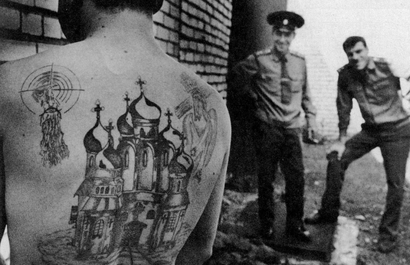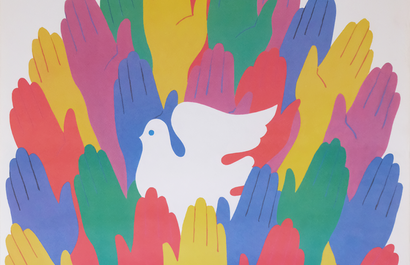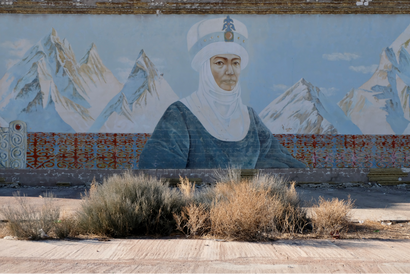Must Read Books on Soviet Art, Design and Culture

Most Russian literature on the list of ‘books you must read’ are old and very long. War & Peace or The Gulag Archipelago are striking works of literature, or so I’m told. Both have sat on my shelf for the past two years. Instead, I’ve put together a list of less intimidating books on Soviet art, design and culture.

Books on Soviet Design
Western culture is built around the notion of choice, disposability and keeping up with the Joneses. Soviet design, on the other hand, prioritised function. Objects were designed to last. From the Lada to Avos'ka string bags, Soviet factories would often produce the same model without change for decades.
- Designed in the USSR, Phaidon - The masterpieces of Soviet design are not found in galleries. They’re found in the homes of the people. This book is a fascinating glimpse into design behind the Iron Curtain, where everyday objects from the functional, to the kitsch, politicized, and avant-garde have their time in the spotlight. From children's toys, homewares, and fashion to posters, electronics, and space-race ephemera, each object reveals something of life in a planned economy during a fascinating time in Russia's history.
- Made in Russia. Unsung Icons of Soviet design, Michael Idov - If Soviet design could be distilled down to a single object, it would be the simplest of shapes...Sputnik. It was a symbol of Soviet superiority. Made in Russia takes the most influential objects of Soviet design and explores their impact on the world at large. I’ve written about the symbol of Sputnik in my blog on Soviet propaganda in the age of the Space race. You can read it here.
- Russian Criminal Tattoo Encyclopaedia, Fuel Publishing - Prison tattoos were a gateway into a secret world. Prison attendant Danzig Baldaev spent decades documenting the tattoos of USSR convicts and their meaning. This books shares some of the more than 3000 tattoos accumulated, from skulls and swastikas, to harems of naked women, a smiling Al Capone, medieval knights in armour, daggers sheathed in blood, benign images of Christ, and sweet-faced mothers and their babies.
- Film Posters of the Russian Avant Garde, Susan Pack - While Comrade Kiev specialises in posters from the 50s through to the late 80s, Russia has a long and colourful history of poster production. Film Posters of the Russian Avant Garde brings together 250 posters from the pre-Stalin 20s & 30s to explore the energy and invention of this period. The Constructivist influence is evident with their unusual angles, dynamic compositions, and startling close-ups.
- Soviet Logos. Lost Marks of the Utopia, Rokas Sutkaitis - The USSR made art a part of the state. Artists were commissioned to create logos by their thousands for any and almost every state company. While only a very small part of them survive today, the ones that do are beautiful. These Soviet logos were the inspiration behind our own Comrade Kiev logo.
- Soviet Visuals, Varia Bortsova - The best snapshots from the cult-classic Twitter account. Varia invites the reader back in time into the strangely captivating world of the Soviet Union-through a unique collection of photography, architecture, propaganda art, advertising, design, and culture from behind the Iron Culture that will fascinate, amuse, and maybe even teach a thing or two

Books on Soviet Architecture
Kandinsky once said that “Every work of art is the child of its age and, in many cases, the mother of our emotions. It follows that each period of culture produces an art of its own which can never be repeated.
- Cosmic Communist Constructions Photographed, Frédéric Chaubin - Soviet architecture was utilitarian. Functional and nothing more. Cosmic Communist Constructions Photographed explores 90 buildings across fourteen former Soviet Republics which express what could be considered as the fourth age of Soviet architecture. They reveal a rebirth of imagination post Stalin, the obsession with the cosmos, an emphasis on massiveness of forms, and the exotic twist of local influences.
- Decommunised: Ukrainian Soviet Mosaics, German Lizaveta, Olʹga N. Balashova, and Yevgen Nikiforov - Mosaics were as influential as propaganda posters in their widespread use and illustration of an idealised Soviet society. Photographer Yevgen Nikiforov spent three years traveling all around Ukraine in search of the most interesting ones. His book includes around 200 photographs of officially sanctioned mosaics featuring workers, farmers, astronauts, and athletes. Some of the pieces featured in the book were torn down shortly after the photographs were taken as they fell afoul of the recent decommunisation laws.

Books on Russia after the USSR
An empire that once spanned a sixth of the world’s land mass, just collapsed overnight. In the new Russia obsessed with image, illusion and glamor, anything is possible.
-
Red Notice: How I Became Putin's No. 1 Enemy, Bill Browder - An emaciated young lawyer, Sergei Magnitsky, is led to a freezing isolation cell in a Moscow prison, handcuffed to a bed rail, and beaten to death by eight police officers. His crime? To testify against the Russian Interior Ministry officials who were involved in a conspiracy to steal $230 million. Magnitsky’s brutal killing has remained uninvestigated and unpunished to this day. Bill Browder shares an extraordinary tale of his battles with ruthless oligarchs in the post-Soviet Union Moscow, and his expulsion from Russia on Putin’s orders.
-
Looking for Lenin, Niels Ackermann and Sébastien Gobert - In 1991, Ukraine had more than 5,500 statues of Lenin — a greater density than in any other part of the former Soviet Union. In the last 20 years, the Ukrainian government has instituted decommunisation or ‘Lenin-fall’, making communist symbols illegal. Today, the only remaining statue of Lenin in Ukraine stands guard at the entrance to Pripyat. The authors have hunted down and photographed these banned Soviet statues in gardens, scrap yards and store rooms.
-
Nothing Is True and Everything Is Possible: The Surreal Heart of the New Russia, Peter Pomerantsev - Welcome to the glittering, surreal heart of twenty-first-century Russia. It is a world erupting with new money and new power, changing so fast it breaks all sense of reality. When British producer Peter Pomerantsev plunges into the booming Russian TV industry, he gains access to every nook and cranny of the country. As the Putin regime becomes more aggressive, Pomerantsev finds himself drawn further into the system.
-
The Taking of K-129: How the CIA Used Howard Hughes to Steal a Russian Sub in the Most Daring Covert Operation in History, Josh Dean - In the summer of 1974, an unusual looking ship left Long Beach, California. Equipped with a giant crane and experimental drilling equipment, the purpose built ship would open up a new frontier in mining, excavating the wealth of the ocean floor. But, the whole expedition was a cover. Six years earlier, the Russian nuclear submarine K-129 was conducting exercises in the Pacific with 98 crew onboard when it vanished. After searching more than 1.3 million square kilometres of ocean, the Soviets called off the search and returned home. But, the United States had other plans. They were going to find and recover the sunken sub. I’ve written about the raising of K-129 on our blog. You can read that story here.







